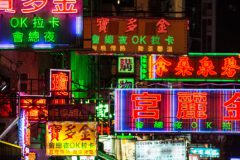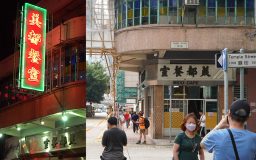Introduction
This video will revolve around the concept of the disappearing neon lights in Hong Kong, hence it is also named “The Afterglow of Hong Kong’s Neon Light”. We set the filming background in Yau Ma Tei, an area where neon lights were once the most dazzling. The theme of the video is the gradually disappearing neon lights, which reflect the changes in Hong Kong culture and image in the context of rapid social development, as well as people’s emotions and views on the passing of neon lights.
Literature Review
The iconic neon lights of Hong Kong have served as a beacon of cultural identity and urban vibrancy, their gradual disappearance marking a significant transformation in the city’s visual narrative. Before the video making, I have explored and looked through some essays and have the further undersatanding about this phenomenon.
Neon lights in Hong Kong have historically been symbolic of the city’s energy and dynamism, illuminating its streets with a colorful glow that became emblematic of its identity. These lights have attracted countless filmmakers and photographers, contributing to the global image of Hong Kong as a bustling metropolis. Their disappearance, ostensibly due to technological advancements and environmental considerations, signifies a shift toward a more standardized urban aesthetic, potentially diluting the unique character of the city. As Li (2017) notes, this transition reflects broader trends in urban development but raises concerns about the erasure of local identity and heritage (Li, D., 2017).
Reflecting on the neon lights from a sociocultural perspective, Chan (2010) emphasizes their role in shaping the social fabric of Hong Kong, suggesting that these illuminated signs have been more than mere advertising tools—they have been integral to the city’s collective memory and shared experiences (Chan, H.L.A., 2010). The gradual eclipse of neon lights, therefore, can be seen as stripping away layers of the city’s history, rendering its urban stories and memories less visible.
The public’s reaction to the disappearance of neon lights has been mixed, with a sense of nostalgia prevalent among many residents. For some, the neon lights represent a connection to a bygone era of Hong Kong, their loss evoking sentimental reflections on change and modernization. Zhang (2018) explores this sentiment, highlighting the emotional resonance of neon lights for many who see them as symbols of Hong Kong’s golden age (Zhang, Y., 2018).
However, there is also an understanding of the practical reasons behind the shift to LED lighting, including energy efficiency and environmental concerns, with some residents recognizing the need for progress and adaptability in the face of global changes.
In sum, the fading of Hong Kong’s neon lights poses critical questions about urban identity, memory, and the balance between preservation and modernization. The disappearance of these lights not only alters the city’s skyline but also reflects deeper shifts in societal values and priorities.
Filming Methods
At the beginning of the video, we stand at the seaside of Kennedy Town and capture the night view of Hong Kong from a horizontal perspective. We can clearly see the dazzling Hong Kong at night, with various colors and purposes of lighting adding a colorful layer to the black sea area shrouded in darkness.
But the light in front of us comes from today’s high-tech, which also makes us imagine whether Hong Kong 20 years ago was also dimly lit? So I designed a timeline, and in the video, we go back to Yau Ma Tei 20 years ago. However, due to our limited resources, I chose a scene from the movie “Little Cheung” from the field trip event. Although the main subject of the scene is not neon lights, but rather worshipping the children of relatives, this has a certain impact. Combined with the dilapidated buildings and shining neon lights as the background, it reflects the neon lights’ companionship to people at night and reflects the color of life at that time – tired and difficult.

The giant wheel of time begins to roll, and we follow the timeline back to the present moment. At this moment,I stood outside the temple street in Yau Ma Tei, quietly waiting for night to fall. The camera also presents a sense of temporal and spatial variation from day to night. The camera moves forward along Temple Street without adding any changes in perspective, taking Yau Ma Tei Temple Street as a microcosm to showcase the night scene of Hong Kong at a close range, as neon lights gradually disappear.

At the end of the video, the background is no longer the Tample Street at night, but the M+ Museum in the West Kowloon Cultural District of Hong Kong. The main subject of the video is still neon lights, but it is no longer as dazzling as before. Instead, it quietly lies in the display window to receive the gaze of tourists, using warmth to warm people’s memories of that era. The video, which is playing in the museum Showcased the process of dismantling neon lights, Not only does it reflect people’s rational side, but it also replaces outdated technology with more advanced products of the times; It also reflects people’s emotional side. All things that were once closely related to people’s lives, as long as they are not the dregs of the times, even if they have been eliminated, are still memories worth cherishing.
Conclusion
If we compare Hong Kong to a woman, she used to have youthful vitality and radiance like a young girl, but with the changes of the times, she is still beautiful. However, she is more mature and introverted, more human and warm, which cannot be separated from the sincere humanistic sentiment and respect for historical culture of the Hong Kong people. As long as this sentiment is not lost, Hong Kong will never become an iceberg beauty in the future.
Words:965
References
Chan, H. L. A. (2010). Tracing a Sense of Place from Urban Heritage Landscape: Case Study in Yau Ma Tei (Doctoral dissertation, Chinese University of Hong Kong). (Chan, H.L.A., 2010).
Li, D. (2017). The Light of Hong Kong: An Analysis on the Changing Urban Aesthetics and Identity. Urban Studies Journal, 54(3), 675-691. (Li, D., 2017).
Zhang, Y. (2018). Nostalgia and the Neon City: Remembering Hong Kong’s Neon Landscape. Cultural Geographies, 25(3), 455-470. (Zhang, Y., 2018).
Director: Xu Jun
Editor: Xu Jun
Xu Jun 3036126874
Video Link: https://youtu.be/T5MkukmDH-I?si=l-oxlWPZDmm-73Qh